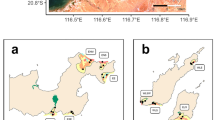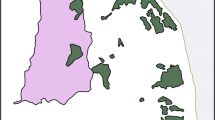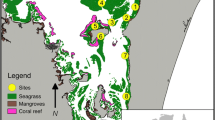Abstract
Context
Whilst the composition and arrangement of habitats within landscape mosaics are known to be important determinants of biodiversity patterns, the influence of seascape patterning and connectivity on temperate reef fish assemblages remains largely unknown.
Objectives
We examined how habitat patterns at multiple spatial scales (100–1000 m) explained the abundance and diversity of temperate reef fish in a reef-seagrass dominated seascape.
Methods
Fish assemblages were surveyed using remote underwater videos deployed on 22 reefs in Jervis Bay, NSW, Australia. Using full-subset GAMMs, we investigated if habitat area, edge, structural connectivity and a metric for habitat diversity (Shannon’s diversity index) of reef and seagrass can predict variations in a temperate reef fish assemblage.
Results
A key finding of the study was that temperate reefs close (< 55 m) to large (> 6.25 ha) seagrass meadows contained greater abundance and diversity of fish. A consistent negative correlation was also found between reef area (> 0.01 ha) and the fish assemblage. The influence of seascape metrics on the abundance of fishes varied with functional traits (trophic groups, mobility and habitat associations). Fish-seascape relationships occurred at a range of spatial scales with no single scale being solely important for structuring the fish assemblage.
Conclusions
We demonstrate that it is important not to view reef habitats in isolation, rather consider a reefs context to adjacent seagrass when predicting the distribution of temperate reef fish. This finding improves current understanding of the multi-scale factors structuring temperate reef fish assemblages and highlights the importance of reef-seagrass connectivty for the management of temperate marine ecosystems.






Similar content being viewed by others
References
Acosta CA, Robertson DN (2002) Diversity in coral reef fish communities: the effects of habitat patchiness revisited. Mar Ecol Prog Ser 227(1):87–96
Andrewartha HG, Birch LC (1954) The distribution and abundance of animals. University of Chicago Press, Chicago
Beets J, Muehlstein L, Haught K, Schmitges H (2003) Habitat connectivity in coastal environments: patterns and movements of Caribbean coral reef fishes with emphasis on bluestriped grunt, Haemulon sciurus. Gulf Carrib Res 14(2):29–42
Bell JD, Westoby M (1986) Variation in seagrass height and density over a wide spatial scale: effects on common fish and decapods. J Exp Mar Biol Ecol 104(1–3):275–295
Berkström C, Gullström M, Lindborg R, Mwandya AW, Yahya SA, Kautsky N, Nyström M (2012) Exploring ‘knowns’ and ‘unknowns’ in tropical seascape connectivity with insights from East African coral reefs. Estuar Coast Shelf Sci 107:1–21
Berkström C, Lindborg R, Thyresson M, Gullström M (2013) Assessing connectivity in a tropical embayment: fish migrations and seascape ecology. Biol Conserv 166:43–53
Bernard ATF, Götz A (2012) Bait increases the precision in count data from remote underwater video for most subtidal reef fish in the warm-temperate Agulhas bioregion. Mar Ecol Prog Ser 471:235–252
BjØrnstad ON, Falck W (2001) Nonparametric spatial covariance functions: estimation and testing. Environ Ecol Stat 8(1):53–70
Bloomfield A, Gillanders B (2005) Fish and invertebrate assemblages in seagrass, mangrove, saltmarsh, and nonvegetated habitats. Estuaries 28(1):63–77
Bologna PA, Heck KL (2002) Impact of habitat edges on density and secondary production of seagrass-associated fauna. Estuaries 25(5):1033–1044
Bond T, Langlois TJ, Partridge J, Birt M, Malseed B, Smith L, McLean D (2018) Diel shifts and habitat associations of fish assemblages on a subsea pipeline. Fish Res 206:220–234
Boström C, Pittman SJ, Simenstad C, Kneib RT (2011) Seascape ecology of coastal biogenic habitats: advances, gaps, and challenges. Mar Ecol Prog Ser 427:191–217
Breheny P, Burchett W (2013) Visualization of regression models using visreg. R package pp 1–5
Burnham KP, Anderson DR (2004) Multimodel inference: understanding AIC and BIC in model selection. Soc Method Res 33(2):261–304
Calabrese JM, Fagan WF (2004) A comparison-shopper’s guide to connectivity metrics. Front Ecol Environ 2(10):529–536
Caldwell IR, Gergel SE (2013) Thresholds in seascape connectivity: influence of mobility, habitat distribution, and current strength on fish movement. Landscape Ecol 28(10):1937–1948
Champion C, Suthers I, Smith J (2015) Zooplanktivory is a key process for fish production on a coastal artificial reef. Mar Ecol Prog Ser 541:1–14
Chittaro BM (2002) Species-area relationships for coral reef fish assemblages of St. Croix, US Virgin Islands. Mar Ecol Prog Ser 233:251–261
Creese R, Glasby T, West G, Gallen C (2009) Mapping the habitats of NSW estuaries. Port Stephens Fisheries Institute, Sydney
Curley BG, Jordan AR, Figueira WF, Valenzuela VC (2013) A review of the biology and ecology of key fishes targeted by coastal fisheries in south-east Australia: identifying critical knowledge gaps required to improve spatial management. Rev Fish Biol Fish 23(4):435–458
Davis JP, Pitt KA, Fry B, Olds AD, Connolly RM (2014) Seascape-scale trophic links for fish on inshore coral reefs. Coral Reefs 33(4):897–907
Dorenbosch M, Grol MGG, Christianen MJA, Nagelkerken I, Van Der Velde G (2005) Indo-Pacific seagrass beds and mangroves contribute to fish density and diversity on adjacent coral reefs. Mar Ecol Prog Ser 302:63–76
Dunning JB, Danielson BJ, Pulliam HR (1992) Ecological processes that affect populations in complex landscapes. Oikos 65:169–175
Edgar GJ, Shaw C (1995) The production and trophic ecology of shallow-water fish assemblages in southern Australia I: Species richness, size-structure and production of fishes in Western Port, Victoria. J Exp Mar Biol Ecol 194(1):53–81
Ferrell DJ, McNeill SE, Worthington DG, Bell JD (1993) Temporal and spatial variation in the abundance of fish associated with the seagrass Posidonia australis in south-eastern Australia. Mar Freshwater Res 44(6):881–899
Fisher R, Wilson SK, Sin TM, Lee AC, Langlois TJ (2018) A simple function for full-subsets multiple regression in ecology with R. Ecol Evol 8(12):6104–6113
Forman RTT, Godron M (1986) Landscape ecology. Wiley, New York
Fowler AM, Chick RC, Stewart J (2018) Patterns and drivers of movement for a coastal benthopelagic fish, Pseudocaranx georgianus, on Australia’s southeast coast. Sci Rep 8(1):16738
Froese R, Pauly D (2010) FishBase. World Wide Web Electronic publication. www.fishbase.org
Gillanders BM (2006) Seagrasses, Fish, and Fisheries. In: Larkum AWD, Orth RJ, Duarte CM (eds) Seagrasses: biology, ecology and conservation. Springer, Netherlands, pp 503–505
Gillanders BM, Able KW, Brown JA, Eggleston DB, Sheridan PF (2003) Evidence of connectivity between juvenile and adult habitats for mobile marine fauna: an important component of nurseries. Mar Ecol Prog Ser 247:281–295
Graham MH (2003) Confronting multicollinearity in ecological multiple regression. Ecology 84(11):2809–2815
Gray CA, McElligott DJ, Chick RC (1996) Intra- and inter-estuary differences in assemblages of fishes associated with shallow seagrass and bare sand. Mar Freshwater Res 47(5):723–735
Green AL, Maypa AP, Almany GR, Rhodes KL, Weeks R, Abesamis RA, Gleason MG, Mumby PJ, White AT (2015) Larval dispersal and movement patterns of coral reef fishes, and implications for marine reserve network design. Biol Rev 90(4):1215–1247
Green BC, Smith DJ, Underwood GJ (2012) Habitat connectivity and spatial complexity differentially affect mangrove and salt marsh fish assemblages. Mar Ecol Prog Ser 466:177–192
Grober-Dunsmore R, Frazer TK, Beets JP, Lindberg WJ, Zwick P, Funicelli NA (2008) Influence of landscape structure on reef fish assemblages. Landscape Ecol 23(S1):37–53
Grober-Dunsmore R, Frazer TK, Lindberg WJ, Beets J (2007) Reef fish and habitat relationships in a Caribbean seascape: the importance of reef context. Coral Reefs 26(1):201–216
Grober-Dunsmore R, Pittman SJ, Caldow C, Kendall MS, Frazer TK (2009) A landscape ecology approach for the study of ecological connectivity across tropical marine seascapes. In: Nagelkerken I (ed) Ecological connectivity among tropical coastal ecosystems. Springer, Dordrecht Heidelberg, pp 493–530
Guisan A, Edwards TC, Hastie TJ (2002) Generalized linear and generalized additive models in studies of species distributions: setting the scene. Ecol Modell 157(2):89–100
Hannan JC, Williams RJ (1998) Recruitment of juvenile marine fishes to seagrass habitat in a temperature Australian estuary. Estuaries 21(1):29–51
Harasti D, Malcom H, Gallen C, Coleman MA, Jordan A, Knott NA (2015) Appropriate set times to represent patterns of rocky reef fishes using baited video. J Exp Mar Biol Ecol 463:173–180
Harvey ES, Cappo M, Butler JJ, Hall N, Kendirck GA (2007) Bait attraction affects the performance of remote underwater video stations in assessment of demersal fish community structure. Mar Ecol Prog Ser 350:245–254
Hastie TJ (2017) Generalized additive models. Statistical models in S. Routledge, Abingdon, pp 249–307
Hastie TJ, Tibshirani R (1987) Generalized additive models: some applications. J Am Stat Assoc 82(398):371–386
Heck Jnr K, Hays G, Orth RJ (2003) Critical evaluation of the nursery role hypothesis for seagrass meadows. Mar Ecol Prog Ser 253:123–136
Heck Jnr K, Hays G, Orth RJ (2008) Trophic transfers from seagrass meadows subsidize diverse marine and terrestrial consumers. Ecosystems 253:1198–1210
Hitt S, Pittman SJ, Nemeth RS (2011) Diel movements of fishes linked to benthic seascape structure in a Caribbean coral reef ecosystem. Mar Ecol Prog Ser 427:275–291
Hixon MA, Beets JP (1989) Shelter characteristics and Caribbean fish assemblages: experiments with artificial reefs. Bull Mar Sci 44(2):666–680
Hutchins B, Swainston R (1986) Sea fishes of southern Australia: complete field guide for anglers and divers. Swainston Publication, Perth
Jackson EL, Attrill MJ, Rowden AA, Jones MB (2006) Seagrass complexity hierarchies: influence on fish groups around the coast of Jersey (English Channel). J Exp Mar Biol Ecol 330(1):38–54
Jelbart JE, Ross PM, Connolly RM (2007) Patterns of small fish distributions in seagrass beds in a temperate Australian estuary. J Mar Biol Assoc UK 87(5):1297–1307
Kendall MS (2005) A method for investigating seascape ecology of reef fish. Proc Gulf Carib Fish Inst 56:1–11
Kendall MS, Miller TJ, Pittman SJ (2011) Patterns of scale-dependency and the influence of map resolution on the seascape ecology of reef fish. Mar Ecol Prog Ser 427:259–274
Kiggins RS, Knott NA, Davis AR (2018) Miniature baited remote underwater video (mini-BRUV) reveals the response of cryptic fishes to seagrass cover. Environ Biol Fishes 101(12):1717–1722
Kuiter RH (1993) Coastal fishes of South-Eastern Australia. Crawford House Press, Honolulu
Lee KA, Huveneers C, Macdonald T, Harcourt RG (2015) Size isn’t everything: movements, home range, and habitat preferences of eastern blue gropers (Achoerodus viridis) demonstrate the efficacy of a small marine reserve. Aquat Conserv 25(2):174–186
MacArthur RH, Wilson EO (1967) The theory of island biogeography. Princeton University Press, Princeton
Martin TSH, Olds AD, Olalde ABH, Berkström C, Gilby BL, Schlacher TA, Butler IR, Yabsley NA, Zann M, Connolly RM (2018) Habitat proximity exerts opposing effects on key ecological functions. Landscape Ecol 33(8):1273–1286
McGrouther MA (2001) The Australian Museum Fish Database. World Wide Web Electronic publication. https://australianmuseum.net.au/learn/animals/fishes/
Moore CH, Van Niel K, Harvey ES (2011) The effect of landscape composition and configuration on the spatial distribution of temperate demersal fish. Ecography 34(3):425–435
Nagelkerken I (2009) Evaluation of nursery function of mangroves and seagrass beds for tropical decapods and reef fishes: patterns and underlying mechanisms. Ecological connectivity among tropical coastal ecosystems. Springer, Dordrecht, pp 357–399
Nagelkerken I, Huebert KB, Serafy JE, Grol MG, Dorenbosch M, Bradshaw CJ (2017) Highly localized replenishment of coral reef fish populations near nursery habitats. Mar Ecol Prog Ser 568:137–150
Nagelkerken I, Sheaves M, Baker R, Connolly RM (2015) The seascape nursery: a novel spatial approach to identify and manage nurseries for coastal marine fauna. Fish Fish 16(2):362–371
Nakamura Y (2010) Patterns in fish response to seagrass bed loss at the southern Ryukyu Islands, Japan. Mar Biol 157(11):2397–2406
Olds AD, Connolly RM, Pitt KA, Maxwell PS (2012) Primacy of seascape connectivity effects in structuring coral reef fish assemblages. Mar Ecol Prog Ser 462:191–203
Ortodossi NL, Gilby BL, Schlacher TA, Connolly RM, Yabsley NA, Henderson CJ, Olds AD (2018) Effects of seascape connectivity on reserve performance along exposed coastlines. Conserv Biol 0:1–10
Parrish JD (1989) Fish communities of interacting shallow-water habitats in tropical oceanic regions. Mar Ecol Prog Ser Oldendorf 58(1):143–160
Parsons DF, Suthers IM, Cruz DO, Smith JA (2016) Effects of habitat on fish abundance and species composition on temperate rocky reefs. Mar Ecol Prog Ser 561:155–171
Perry D, Staveley TAB, Gullström M (2018) Habitat connectivity of fish in temperate shallow-water seascapes. Front Mar Sci 4:001–012
Pittman SJ (ed) (2017) Seascape ecology. Wiley Blackwell, Oxford
Pittman SJ, McAlpine CA (2003) Movements of marine fish and decapod crustaceans: process, theory and application. Adv Mar Biol 44(1):205–294
R Core Development Team (2018) R: A language and environment for statistical computing. R Foundation for Statistical Computing, Vienna, Austria. https://www.R-project.org/
Rees MJ, Jordan A, Price OF, Coleman MA, Davis AR (2014) Abiotic surrogates for temperate rocky reef biodiversity: implications for marine protected areas. Divers Distrib 20(3):284–296
Rees MJ, Knott NA, Davis AR (2018) Habitat and seascape patterns drive spatial variability in temperate fish assemblages: implications for marine protected areas. Mar Ecol Prog Ser 607:171–186
Ricart AM, Sanmartí N, Pérez M, Romero J (2018) Multilevel assessments reveal spatially scaled landscape patterns driving coastal fish assemblages. Mar Environ Res 140:210–220
Sale PF (1998) Appropriate spatial scales for studies of reef-fish ecology. Aust J Ecol 23(3):202–208
Sale PF, Douglas WA (1984) Temporal variability in the community structure of fish on coral patch reefs and the relation of community structure to reef structure. Ecology 65(2):409–422
Sambrook K, Hoey AS, Andréfouët S, Cumming GS, Duce S, Bonin MC (2019) Beyond the reef: the widespread use of non-reef habitats by coral reef fishes. Fish Fish 00:1–18
Schultz AL, Malcolm HA, Bucher DJ, Smith SDA (2012) Effects of reef proximity on the structure of fish assemblages of unconsolidated substrata. PLoS ONE 7(11):1–10
Simberloff D (1976) Experimental zoogeography of islands: effects of island size. Ecology 57(4):629–648
Smith TM, Hindell JS, Jenkins GP, Connolly RM (2008) Edge effects on fish associated with seagrass and sand patches. Mar Ecol Prog Ser 359(1):203–213
Smith KA, Sinerchia M (2004) Timing of recruitment events, residence periods and post-settlement growth of juvenile fish in a seagrass Nursery Area, South-Eastern Australia. Environ Biol Fishes 71(1):73–84
Staveley TAB, Perry D, Lindborg R, Gullström M (2016) Seascape structure and complexity influence temperate seagrass fish assemblage composition. Ecography 39:001–011
Taylor MD, Becker A, Lowry MB (2018) Investigating the functional role of an artificial reef within an estuarine seascape: a case study of yellowfin bream (Acanthopagrus australis). Estuaries Coasts 41(6):1782–1792
Turner MG (2005) Landscape ecology: what is the state of the science? Ann Rev Ecol Evol Syst 36:319–344
Tweedie MC (1984) An index which distinguishes between some important exponential families. Statistics 579:579–604
Unsworth RK, Bell JJ, Smith DJ (2007) Tidal fish connectivity of reef and seagrass habitats in the Indo-Pacific. J Mar Biol Assoc UK 87(5):1287–1296
Valentine JF, Heck KL Jr, Blackmon D, Goecker ME, Christian J, Kroutil RM, Kirsch KD, Peterson BJ, Beck M, Vanderklift MA (2007) Food web interactions along seagrass–coral reef boundaries: effects of piscivore reductions on cross-habitat energy exchange. Mar Ecol Prog Ser 333:37–50
van Lier JR, Wilson SK, Depczynski M, Wenger LN, Fulton CJ (2018) Habitat connectivity and complexity underpin fish community structure across a seascape of tropical macroalgae meadows. Landscape Ecol 33(8):1287–1300
Waycott M, Duarte CM, Carruthers TJ, Orth RJ, Dennison WC, Olyarnik S, Calladine A, Fourqurean JW, Heck KL, Hughes AR, Kendrick GA (2009) Accelerating loss of seagrasses across the globe threatens coastal ecosystems. PNAS 106(30):12377–12381
Wedding LM, Christopher LA, Pittman SJ, Friedlander AM, Jorgensen S (2011) Quantifying seascape structure: extending terrestrial spatial pattern metrics to the marine realm. Mar Ecol Prog Ser 427:219–232
Wellington CM, Harvey ES, Wakefield CB, Langlois TJ, Williams A, White WT, Newman SJ (2018) Peak in biomass driven by larger-bodied meso-predators in demersal fish communities between shelf and slope habitats at the head of a submarine canyon in the south-eastern Indian Ocean. Cont Shelf Res 167:55–64
Williams R, West G, Morrison D, Creese R (2007) Estuarine resources of NSW. The NSW comprehensive coastal assessment toolkit. CD ROM. ISBN: 0.7347:7
Wood SN (2006) Generalized additive models: an introduction with R. Chapman and Hall/CRC
Wood SN, Scheipl F (2014) gamm4: Generalized additive mixed models using mgcv and lme4. R package version 0.2–3
Wood SN, Wood MS (2015) Package ‘mgcv’. R package version 1:29
Wraith J, Lynch T, Minchinton TE, Broad A, Davis AR (2013) Bait type affects fish assemblages and feeding guilds observed at baited remote underwater video stations. Mar Ecol Prog Ser 477:189–199
Wu J (2006) Landscape ecology, cross-disciplinarity, and sustainability science. Landscape Ecol 21:1–4
Young GC, Wise BS, Ayvazian SG (1999) A tagging study on tailor (Pomatomus saltatrix) in Western Australian waters: their movement, exploitation, growth and mortality. Mar Freshw Res 50(7):633–642
Zuur A, Ieno E, Walker N, Saveliev A, Smith G (2009) Mixed effects models and extensions in ecology with R. Springer, New York
Acknowledgements
We thank E. Messer, P. Gordon, J. Lester, C. Virtue, C. Evans-Turner, K. Gilles and K. Swadling for fieldwork assistance. We would also like to thank H. Brown for assisting with the spatial analysis. We acknowledge support from the staff of Jervis Bay Marine Park and Booderee National Park. This research was conducted in accordance to the methods approved by the University of Wollongong’s animal ethics committee (AE 12/07r15), NSW DPI scientific collection permit P01/0059(A)-2.0 and Booderee National Park scientific research permit BDR16/00002.
Author information
Authors and Affiliations
Corresponding author
Additional information
Publisher's Note
Springer Nature remains neutral with regard to jurisdictional claims in published maps and institutional affiliations.
Electronic supplementary material
Below is the link to the electronic supplementary material.
Rights and permissions
About this article
Cite this article
Swadling, D.S., Knott, N.A., Rees, M.J. et al. Temperate zone coastal seascapes: seascape patterning and adjacent seagrass habitat shape the distribution of rocky reef fish assemblages. Landscape Ecol 34, 2337–2352 (2019). https://doi.org/10.1007/s10980-019-00892-x
Received:
Accepted:
Published:
Issue Date:
DOI: https://doi.org/10.1007/s10980-019-00892-x




